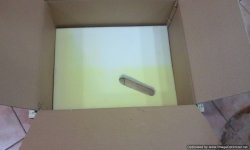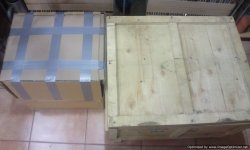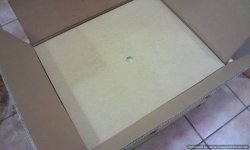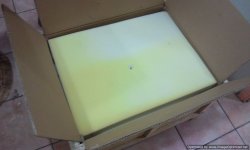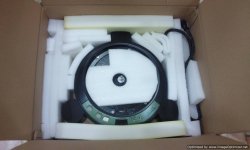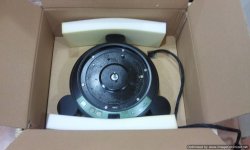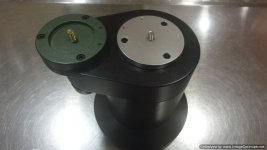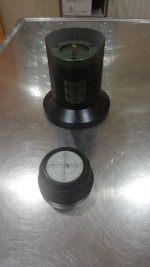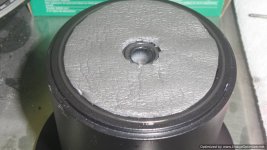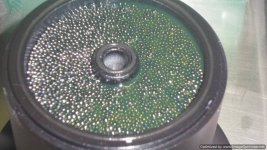soundofvoid,
looking forward to your Pioneer project. Have you ever thought of a project doing an original design for your turntable? Call it the soundofvoid turntable. It does not have to be world class, just practicle.
looking forward to your Pioneer project. Have you ever thought of a project doing an original design for your turntable? Call it the soundofvoid turntable. It does not have to be world class, just practicle.
Ha! You haven't forgot what my plans were!
But this project will be for my personal system...not too many P-3 motors and PL-L1 tangential arms around...and i expect that it's cost will be just like my Mitsubishi project, or even more...$$$$$...
As for an "original" design...i quess you mean something that is not based on an existing turntable...
Let me develop my thinking here:
Nobody says that the X or Y cd player is not original because it uses Phillips or Sony or Sanyo cd mechanisms.
Nobody says the Pagani Huayra is not original because it uses an AMG motor.
Porsche has been renowned for their braking but they use brembo brakes like many others...it's that they fine tune it better than others!
In my next effort (if there will be one) the only thing used from a DP will be the motor itself (with the rotor modified and the axle replaced) and the lower part of the platter that has the magnetic imprinting which i can't reproduce.
Not even the main chassis will be used as i am moving the buttons away to the fascia of the PS/control box.
Is this original enough?
There are sources for a custom direct drive motor but the ones that suit my needs for accuracy and torque have a cost of 1200-1500 euro per item as i want custom spindle configuration.
With the same amount I can get 3 DP-80s per month ( so so condition since i don't care about their visual appearance )...see the difference?
Add that to other costs and whatever you do you cannot escape a net production cost of 5000 euro.
The norm for high end products (since you have to start a business) is that to be viable you cannot sell below X4 the cost...making it a 20000 euro product.
To make it cheaper i have two options:
1)Cut and prepare the metal work in China and do the assembly and electronics in Europe.
2)Buy my own CNC facilities.
The first option is cheaper but i have to guard heavily the quality of work (a lot of travels to Guangzhou!)and the second is initially very expensive but makes you the master of your game...
I can't finance the second option on my own which means taking partner(s)...with a carte blanche?
Decisions, decisions...
As for a more practical design...yes, why not?
I cannot have a line with only one product.
Lesser models will have to be made...but please define "practical"...
Is it price oriented or less cumbersome?
But this project will be for my personal system...not too many P-3 motors and PL-L1 tangential arms around...and i expect that it's cost will be just like my Mitsubishi project, or even more...$$$$$...
As for an "original" design...i quess you mean something that is not based on an existing turntable...
Let me develop my thinking here:
Nobody says that the X or Y cd player is not original because it uses Phillips or Sony or Sanyo cd mechanisms.
Nobody says the Pagani Huayra is not original because it uses an AMG motor.
Porsche has been renowned for their braking but they use brembo brakes like many others...it's that they fine tune it better than others!
In my next effort (if there will be one) the only thing used from a DP will be the motor itself (with the rotor modified and the axle replaced) and the lower part of the platter that has the magnetic imprinting which i can't reproduce.
Not even the main chassis will be used as i am moving the buttons away to the fascia of the PS/control box.
Is this original enough?
There are sources for a custom direct drive motor but the ones that suit my needs for accuracy and torque have a cost of 1200-1500 euro per item as i want custom spindle configuration.
With the same amount I can get 3 DP-80s per month ( so so condition since i don't care about their visual appearance )...see the difference?
Add that to other costs and whatever you do you cannot escape a net production cost of 5000 euro.
The norm for high end products (since you have to start a business) is that to be viable you cannot sell below X4 the cost...making it a 20000 euro product.
To make it cheaper i have two options:
1)Cut and prepare the metal work in China and do the assembly and electronics in Europe.
2)Buy my own CNC facilities.
The first option is cheaper but i have to guard heavily the quality of work (a lot of travels to Guangzhou!)and the second is initially very expensive but makes you the master of your game...
I can't finance the second option on my own which means taking partner(s)...with a carte blanche?
Decisions, decisions...
As for a more practical design...yes, why not?
I cannot have a line with only one product.
Lesser models will have to be made...but please define "practical"...
Is it price oriented or less cumbersome?
Last edited:
Belt drive...it's far easier to make as there is no solid connection between motor and platter.
Even magnetic levitation is dead easy as you don't have interaction with the motor magnetism
I have seen many designers striving for the perfect spindle/axle creation only to ruin it by applying a side force with one only belt...
One has to equalize forces.
You cannot say that you have killed all the mice in the room and pretend not to look at the rat.
In my belt driven Mitsubishi i used two motors that pull the same on opposite directions...thought about three but the third had to sit on top of the turntable...lol!
Personally i like DD.
The only favor i can think for belt drive is a less "edge of seat" sound that suits classical /opera better.
But i've come to understand that by having the same DD motor and changing the
rotating mass you can achieve this effect too.
Less mass = more upfront, more mass= more liquid.
It has to do with motor torque and servo speed correction i guess...
Even magnetic levitation is dead easy as you don't have interaction with the motor magnetism
I have seen many designers striving for the perfect spindle/axle creation only to ruin it by applying a side force with one only belt...
One has to equalize forces.
You cannot say that you have killed all the mice in the room and pretend not to look at the rat.
In my belt driven Mitsubishi i used two motors that pull the same on opposite directions...thought about three but the third had to sit on top of the turntable...lol!
Personally i like DD.
The only favor i can think for belt drive is a less "edge of seat" sound that suits classical /opera better.
But i've come to understand that by having the same DD motor and changing the
rotating mass you can achieve this effect too.
Less mass = more upfront, more mass= more liquid.
It has to do with motor torque and servo speed correction i guess...
It's now packed.
In two big boxes-one wooden/carton one to carry the main chassis and a double carton box for all the smaller stuff.
About a 70Kgs in the big one and 30 kgs in the small...
It has been a long and very stressful build as i had to meet certain deadlines
and always something happened to push be back.
Having to do with all these vendors and parameters is exhausting.
I just wish the owner will enjoy it as much as i dreamed about it and sweated on it's details.
I now need to take a breath before doing it again...
In two big boxes-one wooden/carton one to carry the main chassis and a double carton box for all the smaller stuff.
About a 70Kgs in the big one and 30 kgs in the small...
It has been a long and very stressful build as i had to meet certain deadlines
and always something happened to push be back.
Having to do with all these vendors and parameters is exhausting.
I just wish the owner will enjoy it as much as i dreamed about it and sweated on it's details.
I now need to take a breath before doing it again...
Attachments
soundofvoid,
I have a direct drive turntable, Technics SL-1200. Can you redesign this one and make it your own? Can you create a direct drive from scratch? I know you can create this knind of turntable from scratch as direct drive the best ones are expensive.
Galibier Design - Stelvio
I have a direct drive turntable, Technics SL-1200. Can you redesign this one and make it your own? Can you create a direct drive from scratch? I know you can create this knind of turntable from scratch as direct drive the best ones are expensive.
Galibier Design - Stelvio
And if you have nothing better to do you can take a crack at a diy tone arm.
Good luck in 2015.
Good luck in 2015.
I can work on anything that falls in my hands.
TBH the SL-1200 is a good one but good enough to throw $$$$ on it?
I could see one and say what could be bettered, but i would prefer working
on a better candidate.
But if you really want to...
Arm?
Not at the moment.
Turntables and speakers are my field.
If i had to work on a arm i would prefer working on a servo driven tangential one.
With todays ultra fast electronics and modern ultra ligh and stiff materials...
Oh la la!
TBH the SL-1200 is a good one but good enough to throw $$$$ on it?
I could see one and say what could be bettered, but i would prefer working
on a better candidate.
But if you really want to...
Arm?
Not at the moment.
Turntables and speakers are my field.
If i had to work on a arm i would prefer working on a servo driven tangential one.
With todays ultra fast electronics and modern ultra ligh and stiff materials...
Oh la la!
Hello soundofvoid
You took the words out of my mouth.
Sincerely,
Ralf
If i had to work on a arm i would prefer working on a servo driven tangential one.
With todays ultra fast electronics and modern ultra ligh and stiff materials...
Oh la la!
You took the words out of my mouth.
Sincerely,
Ralf
Ηonestly Ralf, emmm...i meant "ultra light and stiff materials"
I have in my disposal two servo driven tangential arms.
The one in my "kicked in the butt" Mitsubishi and arguably the best ever built:
the one from the Pioneer PL-L1.
Both work SUPERB.
The concept of the magnetic induction driven L-1 arm is indeed very tempting...
I have in my disposal two servo driven tangential arms.
The one in my "kicked in the butt" Mitsubishi and arguably the best ever built:
the one from the Pioneer PL-L1.
Both work SUPERB.
The concept of the magnetic induction driven L-1 arm is indeed very tempting...
Straight Tracker,
I know that the best things in life are worth waiting for. Since 2010 you have been working on your magnificent tonearm. status? The world is waiting.
I know that the best things in life are worth waiting for. Since 2010 you have been working on your magnificent tonearm. status? The world is waiting.
The concept of the magnetic induction driven L-1 arm is indeed very tempting...
I owned the Pioneer PL-L1000 with same concept before but I would prefer it moves only one direction. Put on an off-centered record and it wriggles left and right struggling to keep tangency seems disturbing. I prefer the Rabco idea of only sliding one direction.
What I really want to see is a sliding base that allows for mounting pivot arm. Modern pivot arms are quite evolved, no need to reinvent the wheel, just choose an arm (12" arm probably accommodates more turntable sizes) with no offset angle at the pivot and take out the offset angle at the headshell and let it slide in a servo system. More of a servo island that can mount an arm and let it slide 4" of lateral movement. To save space, a circular mount that pivots guided by the Thales principle should also work. The trick is to obtain servo precision and during movement no vibration and maintain rigidity.
I look forward to your and Ralf's future invention!
TBH, the medium's flaw (off centered vinyl hole) cannot be blamed on the arm!
Going back and forth means that the arm can cope with the off center circle it tracks.
Going only one way (forth i guess!) means that it cannot correct ... you hear parts of the music piece with increased offset error.
The PL-L1 arm is doing away with much of this limbo motion that plagues lighter arm-carriers by having so much weight on it's sliding base (about 1.5 kilos in total!) that the inertia "filters" most of the unwanted movement.
Actually the Mitsubishi has a safety margin that the Pioneer lacks: if it senses too much deviation (i have seen records that need a good 5mm back and forth movement of the arm to track!) the arm lifts on it's own and parks!
I guess if it had a digital display one would read: "give me a break man!"
The Thales concept "servo sliding base" solves some problems but could very well impose new ones...for example how about the rigidity of the whole arm base and the noise it will induce on this very crucial part...
I would think that it's always easier to move and control the movement of the lighter part (headshell-cartridge) than the much heavier rear part...?
On the other side Sony has done just that in it's best CD drives.
The whole spinning cd + mechanism moves against a stationary laser...go figure!
Going back and forth means that the arm can cope with the off center circle it tracks.
Going only one way (forth i guess!) means that it cannot correct ... you hear parts of the music piece with increased offset error.
The PL-L1 arm is doing away with much of this limbo motion that plagues lighter arm-carriers by having so much weight on it's sliding base (about 1.5 kilos in total!) that the inertia "filters" most of the unwanted movement.
Actually the Mitsubishi has a safety margin that the Pioneer lacks: if it senses too much deviation (i have seen records that need a good 5mm back and forth movement of the arm to track!) the arm lifts on it's own and parks!
I guess if it had a digital display one would read: "give me a break man!"
The Thales concept "servo sliding base" solves some problems but could very well impose new ones...for example how about the rigidity of the whole arm base and the noise it will induce on this very crucial part...
I would think that it's always easier to move and control the movement of the lighter part (headshell-cartridge) than the much heavier rear part...?
On the other side Sony has done just that in it's best CD drives.
The whole spinning cd + mechanism moves against a stationary laser...go figure!
The Thales concept "servo sliding base" solves some problems but could very well impose new ones...for example how about the rigidity of the whole arm base and the noise it will induce on this very crucial part...
The concept is closer to the Birch idea, think of an active servo version of the Schroeder LT tonearm. The base would be pivoting instead of gliding laterally, hence linear bearing not needed, which can result in lower noise and higher rigidity. But the conventional active linear arm probably works just fine if the servo is accurate and the gliding mechanism is low noise. At least it's geometrically less confusing.
The new owner has received and set it up with his Kuzma 4point arm and Kuzma cartridge.
His comments are very favorable so far...
He has made a note of the bass slam,solidity of image,quiet operation and lack of feedback even playing at very high volume levels.
He is in love with the periphery ring and the things it does to the sound.
After testing with and without he said that he can't think of playing another record
without it.
And sent a photo of the setup...complete with two granite plates with damping material in between and the finite elememente adjustable feet...
His comments are very favorable so far...
He has made a note of the bass slam,solidity of image,quiet operation and lack of feedback even playing at very high volume levels.
He is in love with the periphery ring and the things it does to the sound.
After testing with and without he said that he can't think of playing another record
without it.
And sent a photo of the setup...complete with two granite plates with damping material in between and the finite elememente adjustable feet...
Attachments
It has been some time since there was an update on the subject...
The dealer in question after having spent six months testing it, has decided to present the turntable at the Hong Kong audio show (7-9/Aug) and asked for a second tonearm base...this time for a Triplanar VII arm.
He provided me with the measurements i wanted and i have asked for the arm's base collar to see if i could improve on it.
Having time to rethink some aspects of the original construction i have done some alterations to the original design...keeping the external look identical.
1) I used a thicker wall (10mm vs 5mm) main body.
2) I have incorporated o-rings on the top of the main body under the top plate to prevent oil spill in case the base is inversed during shipping - it has happened!
3) I have asked for welding of the base and central cylinder to make sure everything
was leak-proof. In the prototype they were epoxy-glued together.
All parts were cut from inox except for the top plate that is aluminum.
I would have liked cutting the base part from bronze but that would add cost a bit more and i was working against a specific price point.
Some other parts having to do with the securing of the tonearm were cut from solid bronze.
This is what i received for the main body...
The dealer in question after having spent six months testing it, has decided to present the turntable at the Hong Kong audio show (7-9/Aug) and asked for a second tonearm base...this time for a Triplanar VII arm.
He provided me with the measurements i wanted and i have asked for the arm's base collar to see if i could improve on it.
Having time to rethink some aspects of the original construction i have done some alterations to the original design...keeping the external look identical.
1) I used a thicker wall (10mm vs 5mm) main body.
2) I have incorporated o-rings on the top of the main body under the top plate to prevent oil spill in case the base is inversed during shipping - it has happened!
3) I have asked for welding of the base and central cylinder to make sure everything
was leak-proof. In the prototype they were epoxy-glued together.
All parts were cut from inox except for the top plate that is aluminum.
I would have liked cutting the base part from bronze but that would add cost a bit more and i was working against a specific price point.
Some other parts having to do with the securing of the tonearm were cut from solid bronze.
This is what i received for the main body...
Attachments
-
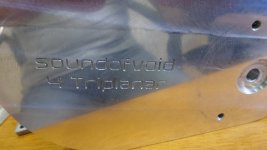 20150609_192318 (FILEminimizer).jpg69 KB · Views: 114
20150609_192318 (FILEminimizer).jpg69 KB · Views: 114 -
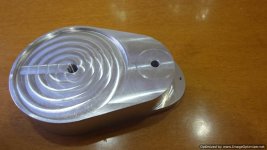 20150605_193721-Optimized.jpg95.7 KB · Views: 116
20150605_193721-Optimized.jpg95.7 KB · Views: 116 -
 20150605_193706-Optimized.jpg82.2 KB · Views: 289
20150605_193706-Optimized.jpg82.2 KB · Views: 289 -
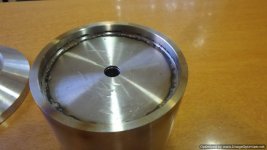 20150605_193556-Optimized.jpg79.7 KB · Views: 287
20150605_193556-Optimized.jpg79.7 KB · Views: 287 -
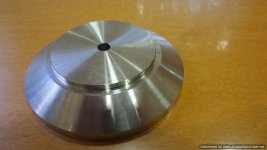 20150605_193532-Optimized.jpg82.9 KB · Views: 304
20150605_193532-Optimized.jpg82.9 KB · Views: 304 -
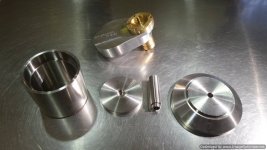 20150529_192612-Optimized.jpg119.6 KB · Views: 320
20150529_192612-Optimized.jpg119.6 KB · Views: 320
I have cut from bronze all the parts having to do with the fixing in place of the tonearm.
A new collar with an o-ring on the underside (to aid damping), a long headless screw that would replace the original one and a round stabilizer weight that would screw against the underside of the top aluminum plate.
This will have a thick o-ring incorporated to the contact point...
All this of course needed a bit of prep work before the final coats could be applied...
A new collar with an o-ring on the underside (to aid damping), a long headless screw that would replace the original one and a round stabilizer weight that would screw against the underside of the top aluminum plate.
This will have a thick o-ring incorporated to the contact point...
All this of course needed a bit of prep work before the final coats could be applied...
Attachments
-
 20150707_203526-Optimized.jpg71.6 KB · Views: 76
20150707_203526-Optimized.jpg71.6 KB · Views: 76 -
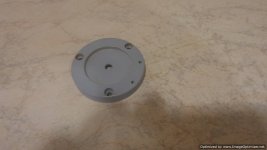 20150707_203512-Optimized.jpg64.7 KB · Views: 81
20150707_203512-Optimized.jpg64.7 KB · Views: 81 -
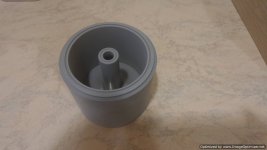 20150707_203427-Optimized.jpg61.9 KB · Views: 82
20150707_203427-Optimized.jpg61.9 KB · Views: 82 -
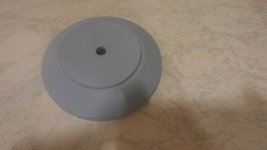 20150707_203401 (FILEminimizer).jpg49.6 KB · Views: 92
20150707_203401 (FILEminimizer).jpg49.6 KB · Views: 92 -
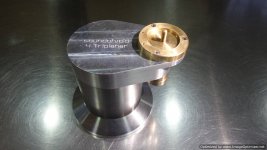 20150605_200320-Optimized.jpg123.9 KB · Views: 99
20150605_200320-Optimized.jpg123.9 KB · Views: 99 -
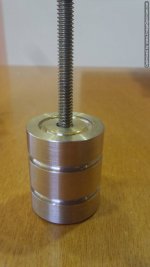 20150605_193903-Optimized.jpg75.2 KB · Views: 92
20150605_193903-Optimized.jpg75.2 KB · Views: 92 -
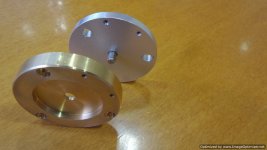 20150605_193841-Optimized.jpg86.6 KB · Views: 95
20150605_193841-Optimized.jpg86.6 KB · Views: 95
After that stage it was time for painting them...in the same BMW black and Nissan green.
Three coats of color and three coats of clear coat made the deal.
I have used the same technique for topping up the hollow body as in the previous tonearm tower:lead shot and gearbox oil.
Two layers of pliable material with lead sheet were used at the bottom and top of the main body for extra vibration absorption.
The o-rings made it a liquid tight seal and all looked fine.
Voila!
Three coats of color and three coats of clear coat made the deal.
I have used the same technique for topping up the hollow body as in the previous tonearm tower:lead shot and gearbox oil.
Two layers of pliable material with lead sheet were used at the bottom and top of the main body for extra vibration absorption.
The o-rings made it a liquid tight seal and all looked fine.
Voila!
Attachments
In our talks he mentioned a problem with hum picking up through the tonearm cables.
In the Triplanar arm more so than the Kuzma.
After trying to establish the weak points in the route of the phono cables, it was obvious that the junction boxes were the problem.
The Kuzma box was out of aluminum but had a substantial length of "naked" cable inside whether the Triplanar one was made from plastic!
I offered to make him "cover" boxes out of cast aluminum lined with Mu metal hoping that there will be an audible difference.
Here's what i finally made, finished in the same black and green colors...
In the Triplanar arm more so than the Kuzma.
After trying to establish the weak points in the route of the phono cables, it was obvious that the junction boxes were the problem.
The Kuzma box was out of aluminum but had a substantial length of "naked" cable inside whether the Triplanar one was made from plastic!
I offered to make him "cover" boxes out of cast aluminum lined with Mu metal hoping that there will be an audible difference.
Here's what i finally made, finished in the same black and green colors...
Attachments
-
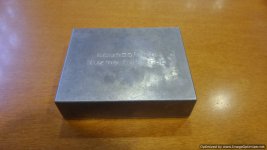 20150619_183110-Optimized.jpg91.7 KB · Views: 93
20150619_183110-Optimized.jpg91.7 KB · Views: 93 -
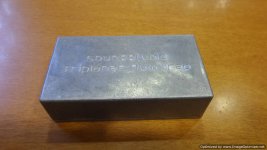 20150619_183053-Optimized.jpg97.1 KB · Views: 84
20150619_183053-Optimized.jpg97.1 KB · Views: 84 -
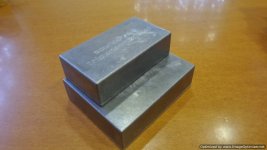 20150619_183136-Optimized.jpg74.2 KB · Views: 83
20150619_183136-Optimized.jpg74.2 KB · Views: 83 -
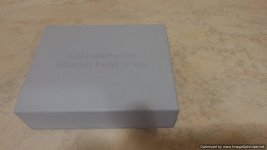 20150707_203604-Optimized.jpg57.3 KB · Views: 67
20150707_203604-Optimized.jpg57.3 KB · Views: 67 -
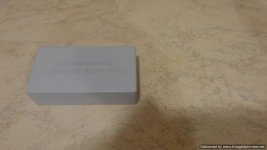 20150707_203712-Optimized.jpg63.2 KB · Views: 73
20150707_203712-Optimized.jpg63.2 KB · Views: 73 -
 20150715_210051-Optimized.jpg111.1 KB · Views: 87
20150715_210051-Optimized.jpg111.1 KB · Views: 87
- Status
- Not open for further replies.
- Home
- Source & Line
- Analogue Source
- My new effort on making the ultimate DP-80
